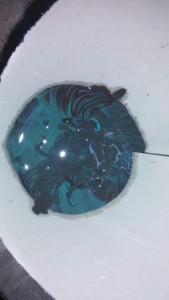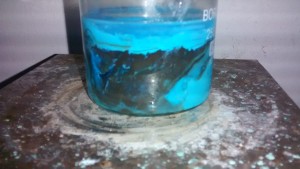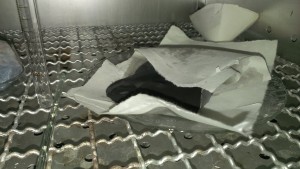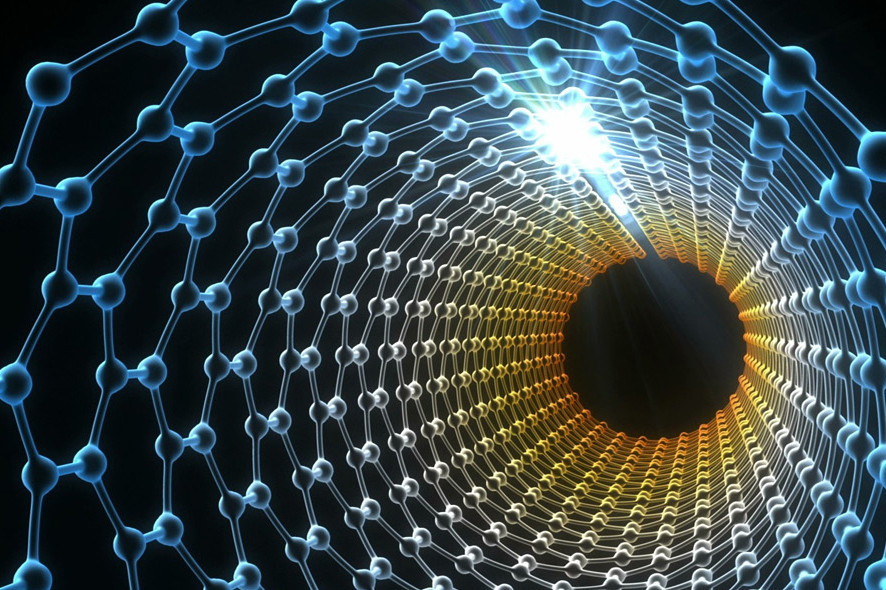I still remember that day when Hod sir asked for names of students who were interested in preparing Nano particles. Around 15 students were interested, so we formed four teams and started of with the work. We were guided by the Respected Director of Nano Ram Technologies, A.R. Phani sir. Before we could start of with preparation, we had some theory classes on what Nano means and why were we preparing them etc. Finally, the four particles we were preparing were Copper oxide, Aluminium Oxide, Zinc Oxide and Iron oxide. I was placed in the group of Copper oxide, which, uhm! had some unique properties that posed difficulties at multiple stages of its preparations.
Initially, we had to assemble all the required raw materials like salts of required oxides, Magnetic stirrer, bead and some apparatus like beakers, dishes etc, which we assembled within no time only with an exception of the Magnetic stirrer which kind of took some time as we had to get it repaired. It requires around 4 hours to prepare one sample in which around 3 hours we just had to sit idle and watch the reaction and mixing of various solutions. It sounds a lot irritating but once involved, believe me, that is the most fun part as you get to the see the reaction.
We initiated the preparation, and stayed back that night.We started preparing the particles at 6 PM, since it was the first time, the process completed at 12 PM. But, the unfortunate part, we ended up with maybe very few milligrams of powder precipitate. “Ah! what were we supposed to do now, ” was the question in our minds, however we students of BVRIT are very concrete in terms of will power, so I picked up my phone and called sir, ” Sir! we expected grams, but we got milligrams, so what do we do?”; after taking inputs from sir and clarifying all doubts by making very few calls; just around 15 to 20 calls as far as I remember. By repeating the laborious 4 hours process for 3 times with different chemical combinations we got the desired output. I still remember that moment, where just before ten minutes of completion, particles of Copper Oxide started separating from gel like solution and they danced in between the layers. This reaction gave a shinny appearance to the solution and I can never forget that moment where our faces were shining more than the solution did. My team all at a sudden became experts of Nano particle preparations, and started guiding the other teams in their preparations too. Our next task was to send the samples for characterization i.e., analyzing amount and structure of prepared particles and testing them in the heat exchanger equipment. Oh yea, I forgot to te
combinations we got the desired output. I still remember that moment, where just before ten minutes of completion, particles of Copper Oxide started separating from gel like solution and they danced in between the layers. This reaction gave a shinny appearance to the solution and I can never forget that moment where our faces were shining more than the solution did. My team all at a sudden became experts of Nano particle preparations, and started guiding the other teams in their preparations too. Our next task was to send the samples for characterization i.e., analyzing amount and structure of prepared particles and testing them in the heat exchanger equipment. Oh yea, I forgot to te ll, the main purpose of preparing these particles was to suspend them in water and test it in the heat exchanger present in the Heat Transfer lab. All conventional heat exchange fluids were running at low efficiency and all structures like fins, baffles have reached to their practical limits of usage. So going to basics, making nano sized particle metal powders and suspending them in conventional fluids will theoretically improve heat transfer due to increase in surface area, more zig-zag movement and a phenomena known as Nucleate Boiling.
ll, the main purpose of preparing these particles was to suspend them in water and test it in the heat exchanger present in the Heat Transfer lab. All conventional heat exchange fluids were running at low efficiency and all structures like fins, baffles have reached to their practical limits of usage. So going to basics, making nano sized particle metal powders and suspending them in conventional fluids will theoretically improve heat transfer due to increase in surface area, more zig-zag movement and a phenomena known as Nucleate Boiling.
We took help of VIPER, the Pharmacy college of BVRIT, for more resources and space and started preparing two to three samples at a time. Finally we completed 12 samples and divided each into further four samples. Each divided sample was dried for one day and sintered in the furnace for 3 hrs at 4 different temperatures.
completed 12 samples and divided each into further four samples. Each divided sample was dried for one day and sintered in the furnace for 3 hrs at 4 different temperatures.
I still remember how we burnt the pipes of sink with acid; of course done by mistake, pushed friends towards the beaker with unbearable odour coming from it, in fact one of the smell was so peculiar and different that, I became an expert in recognizing it and my friends used my talent like an indicator for the foul smelling gas leakage in experiments. Anyways, jokes apart, as soon as we finished sintering the samples, we sent them to Bangalore for characterization.Recently, Nano technology Innovation Centre was inaugrated by Chairman sir, Sri K.V. Vishnu Raju garu, accompanied by Vice Chairman sir, Head Of Department of Mechanical Engineering and faculty members. As of now, we are waiting for the results and very soon we will be testing them in the equipment and we are confident that our hard work will lead to a new invention that will drive the upcoming technologies in a more effective manner. Okay friends, as of now I am taking leave, but very soon I will comeback with the updates of the characterization and test results.












